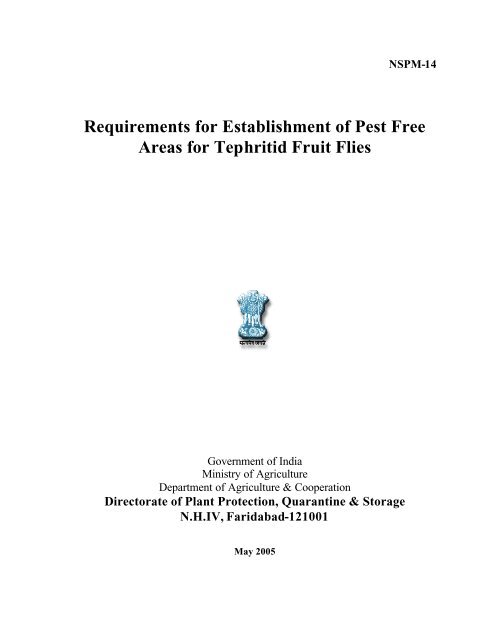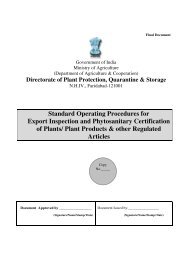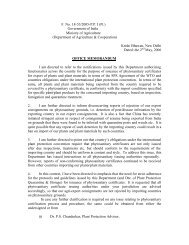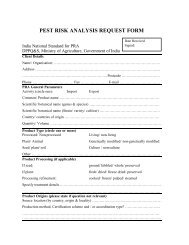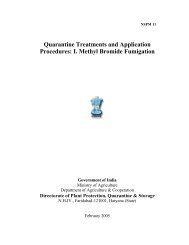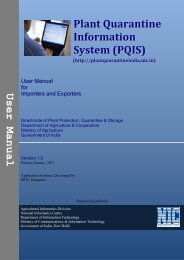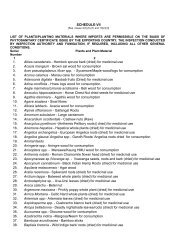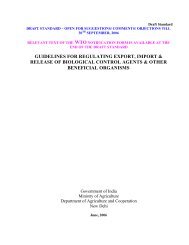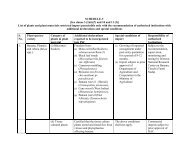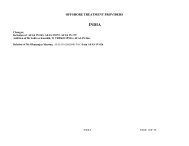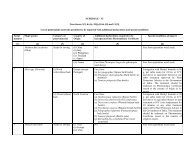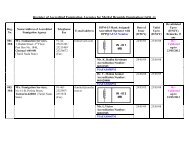NSPM-14 - Plant quarantine India
NSPM-14 - Plant quarantine India
NSPM-14 - Plant quarantine India
- No tags were found...
You also want an ePaper? Increase the reach of your titles
YUMPU automatically turns print PDFs into web optimized ePapers that Google loves.
<strong>NSPM</strong>-<strong>14</strong>Requirements for Establishment of Pest FreeAreas for Tephritid Fruit FliesGovernment of <strong>India</strong>Ministry of AgricultureDepartment of Agriculture & CooperationDirectorate of <strong>Plant</strong> Protection, Quarantine & StorageN.H.IV, Faridabad-121001May 2005
ContentsS. No. Topic Page No.Title 1Contents 2Endorsement 4Review & Amendment 5Control & Distribution 5Introduction 6Scope 6Background 6References 6Definitions & abbreviations 7Outline of requirements 81.0. General Requirements 91.1. Documentation of information 91.2. Operation of national plan 91.3. Management structure & responsibilities 91.4. Qualification of field inspectors & training requirements 101.5. Funding 102.0. Specific Requirements 102.1. Definition of area 102.2. Survey plan 102.3. Requirements of survey 112.4. Trapping density 112.5. Trap positioning & marking 122.6. Quarantine surveillance 122.7. Grid mapping 132.8. Trap/lure types used 132.9. Inspection & recharging of traps <strong>14</strong>2.10. Servicing kit <strong>14</strong>2.11. Trap inspection & monitoring 152.12. Record of trapping data 152
2.13. Collection & forwarding of trapped flies 152.<strong>14</strong>. Relocation of traps 162.15. Reporting results of survey 162.16. Supplementary trapping 162.17. Fruit inspection/sampling 162.18. Suspension & reinstatement of pest free status 172.19. Auditing & Review 17AppendicesAppendix-1: Particulars of trap type/lures against fruit fly species 18Appendix-2: Application volume of lure plus insecticide to each trap 18Appendix-3: Mixtures for McPhail traps 19Appendix-4: Field record sheet for fruit flies 20Appendix-5: Specimen forwarding form 21Appendix-6; Specimen identification report form 22Appendix-7: Fruit fly surveillance & monitoring Report 23Appendix-8: Preparation and dispatch of fruit fly larvae for identification 24Appendix-9; Auditing of fruit fly surveillance and monitoring programme 25-293
EndorsementThis standard on ‘Requirements for Establishment of Pest Free Areas forTephritid Fruit flies’ provides necessary guidance and requirements for establishment,maintenance and verification of pest free areas for fruit flies and use as a risk managementoption for undertaking phytosanitary certification of export of fresh fruits of mango frompest-free areas or provide scientific justification for phytosanitary measures for protection ofendangered pest free area. This standard would enable the recognition of pest free areas inline with provisions of international agreements and thus facilitate the trade.This standard is approved for adoption on 12 th May 2005 by:_________________(P.S. Chandurkar)<strong>Plant</strong> Protection AdviserDte of <strong>Plant</strong> Protection, Quarantine & Storage,NH-IV., Faridabad-121001.4
INTRODUCTIONSCOPEThis standard describes the specific requirements for the establishment, maintenance andverification of pest free areas (PFAs) for fruit flies of Tephritidae in line with theinternational standards on phytosanitary measures established by IPPC, FAO, Rome.BACKGROUNDThe NPPO of exporting countries would be required to establish fruit fly free areas, in orderto consider the export of fresh fruits without any post-harvest treatment, including detaileddescription of the activities to maintain the condition in the area to guarantee the soundnessof the surveillance and monitoring system used. Once the NPPO of importing countryapproves the condition of the area as pest free, the NPPO of exporting country shallcommunicate the name of an official responsible for periodically providing information ontrapping measures at the national level as well as the name of specialists authorized toperform the official identification of fruit fly specimens which may appear in the area ofinterest. Further records of the daily activities, which are carried out to maintain the conditionin that area including audits should be made available. It is also considered necessary to usestandard traps, specific lures and harmonized trapping procedures and proper documentationof records to ensure the fruit fly free area status is maintained so as to comply with therequirements of importing country.Adoption of uniform and harmonized survey and monitoring protocols are critical forestablishment of fruit fly area freedom in the designated pest free areas using permanenttrapping grids. The surveys are required to be carried out over a continuous period of 12months during which period no detection of suspected fruit fly should occur. If fruit flies aredetected and subsequently eradicated, the surveys should be continued for another 12 monthsfrom the date of eradication.REFERENCESAgreement on the Application of Sanitary and Phytosanitary Measures, 1994. WorldTrade Organization, Geneva.Determination of pest status in an area. ISPM No. 8, FAO, RomeGlossary of phytosanitary terms, 2002. ISPM No. 5 (Rev.), FAO, Rome.Guidelines for pest risk analysis, 1996. ISPM No.2, FAO, Rome.Guidelines for surveillance, 1998. ISPM No. 6, FAO, Rome.International <strong>Plant</strong> Protection Convention, 1997. FAO, Rome.Requirements for the establishment of pest free areas, 1997. ISPM No. 4, FAO, RomeA submission supporting area freedom from Queens land fruit fly and Mediterranean fruit flyfor the Riverland, Sun raysia and Riverina pest free areas of mainland Australia. October2000. AQIS, Department of Agriculture, Fisheries and Forestry, Canberra ACT, Australia.Surveillance for <strong>quarantine</strong> fruit flies (in a portion of a generally infested area).1998. RSPMNo.10, NAPPO, Ontario, Canada6
DEFINITIONS AND ABBREVIATIONSArea:An officially defined country, part of a country orall or parts of several countries.Buffer zone:Delimiting survey:Detection survey:An area in which a specific pest does not occur or occurs at alow level and is officially controlled, that either encloses oradjacent to an infested area, an infested place of production ora pest free production site, and in which phytosanitarymeasures are taken to prevent the spread of the pest.Survey conducted to establish the boundaries of anarea considered to be infested by or free from a pest.Survey conducted in an area to determine if pestsare present.IPPC: International <strong>Plant</strong> Protection Convention as deposited in 1951with FAO, Rome and as subsequently amended.Monitoring survey:National <strong>Plant</strong> ProtectionOrganization (NPPO):Official:.Pest:Pest free area (PFA):Pest record:Ongoing survey to verify the characteristics of apest population.Official service established by a government to discharge thefunctions specified by the IPPC.Established, authorized or performed by a NPPOAny species, strain or biotype of plant, animal, orpathogenic agent injurious to plants or plant products.An area in which a specific pest does not occur as demonstratedby scientific evidence and in which, where appropriate, thiscondition is being officially maintained.A document providing information concerning the presence orabsence of a specific pest at a particular location, at a certaintime, with in an area (usually a country) under describedcircumstancesPest status (in area): Presence or absence, at the present time, of a pest in an area,including where appropriate its distribution, as officiallydetermined using expert judgment on the basis of current andhistorical pest records and other information.Phytosanitary certification:Use of phytosanitary procedures leading to the issue ofphytosanitary certificate7
Phytosanitary measure:Phytosanitary regulation:Quarantine pest:Survey:Surveillance:Any legislation, regulation or official procedure having thepurpose to prevent the introduction and/or spread of pests.Official rule to prevent the introduction and/or spread of<strong>quarantine</strong> pests, by regulating the production, movement orexistence of commodities or other articles, or the normalactivity of persons, and by establishing schemes forphytosanitary certification.A pest of potential economic importance to the areaendangered thereby and not yet present there, or present but notwidely distributed and being officially controlled.An official procedure conducted over a definite period todetermine the characteristics of a pest population or todetermine which species occur in an area.An official process, which collects and records data on pestoccurrence or absence by survey, monitoring or otherprocedures.OUTLINE OF REQUIREMENTSThis standard outlines procedures for undertaking surveillance and monitoring protocols forfruit flies. The development of such protocols are critical for establishment of fruit fly freeareas in line with the established international standards. Collection and documentation ofinformation regarding the occurrence and distribution of fruit fly species and their hostspecies, operation of a national plan with clearly defined management structure andresponsibilities is vital for the success of the programme and also qualified and trained fieldinspectors and the adequate funding to meet the operational costs.It is very much essential to delimit the proposed areas by recognised natural boundaries orreference points for establishment of fruit fly free areas and should be isolated sufficiently bya buffer zone represented by sparsely thin vegitation or absence of non-host species. Furtherthis standard describes the operating procedures especially correct trapping density forestablishing permanent trapping grids and correct positioning of traps, trap types and lures,recharging of traps, inspection and monitoring of traps at specified intervals and collectionand forwarding of trapped flies for identification and action to be taken in the event ofdetection of fruit fly species such as supplementary trapping and systemic fruit inspectionand sampling8
1.0. GENERAL REQUIREMENTS1.1. Documentation of informationThe information on detailed occurrence and distribution of various fruit fly species(Bactrocera spp.) in <strong>India</strong> and their host range should be clearly documented based on theliterature search and as verified by the specimens deposited with the national insectcollection maintained by the Division of Entomology, <strong>India</strong>n Agriculture Research Institute,New Delhi or any other authenticated insect collection and pest recods.1.2. Operation of national planThe Central Government should establish a national plan for fruit fly surveillance involvingState Governments and the associated bodies, research institutions, agriculture universities,growers associations etc., and the plan of action, management structure and responsibilities,training and resource requirements and budgetary support should be clearely documented.Such plan should include <strong>quarantine</strong> surveillance against exotic fruit fly incursions andemergency action plans.1.3. Management structure & responsibilitiesDirectorate of <strong>Plant</strong> protection, Quarantine & Storage (Dte of PPQS) established underMinistry of Agriculture, being the National <strong>Plant</strong> Protection Organization has the overallresponsibility for organizing survey and monitoring programmes for determination of pestfree areas (PFAs) in association with the State Governments. The State Directorate ofHorticulture/Agriculture should nominate a programme coordinator for effectiveimplementation of the regular survey and monitoring programme for fruit flies in therespective state and should ensure that the overseas country requirements are met with byensuring the day to day running of the regular fruit fly monitoring programme and alsoresponsible for timely reporting the survey results and take immediate necessary action in theevent of detection of any fruit flies. The state programme coordinators should operatepermanent trapping grids in the designated PFAs. For this purpose, suitably qualified andtrained field inspectors should be employed or contracted for regular operation of trappinggrids established in the designated PFAs. The field inspectors should be made responsible forthe development of the trapping grids in the designated PFA’s and, maintaining grid maps,installation of traps and detailed pest records. They should ensure proper inspection of trapsis carried out at regular intervals as required, recharging/replacement of traps as considerednecessary at specified intervals, collection and forwarding of specimens to referenceentomologist for identification, timely reporting of the activities and effectiveimplementation of appropriate measures following the detection of fruit flies of concern.A Reference Entomologist should be nominated by the respective State AgricultureUniversity (SAU) and approved by the <strong>Plant</strong> Protection Adviser, who is responsible for thetimely identification of all larvae and adults of fruit flies (Bactrocera spp.) that are referredthrough the monitoring programmme or any other source. The reference entomologist9
nominated by the respective SAUs should have the requisite expertise in preciseidentification of fruit fly species.1.4. Qualification & training requirements of field inspectorsThe field inspectors employed/contracted under the programe should have a minimum ofbasic degree in Agriculture/Horticulture and have been adequately trained in the field of fruitfly surveillance viz., identification of fruit flies, preparation of trapping grids, trappositioning, type of lures and their preparation, inspection and recharging traps, recordingtrap data, collection and forwarding of specimens for identification and management of pestrecords. The training programme for field inspectors should be arranged either at the <strong>India</strong>nInstitute of Horticulture Research, Bangalore or Central Institute for Sub-tropicalHorticulture Research, Lucknow at the beginning of each programme. At the end of training,the field inspectors should be audited for evaluating their fruit fly surveillance capabilities.1.5. FundingThe Central Government through Directorate of <strong>Plant</strong> protection, Quarantine & Storageshould provide appropriate budgetary support for operation of regular fruit fly surveillanceprogramme in the designated PFA’s in respective state At the beginning of each financialyear, the respective state programme coordinators should submit appropriate proposals alongwith the survey plans to the <strong>Plant</strong> Protection Adviser for approval. The proposals shouldreflect the cost of operation of surveillance and monitoring programme in designated PFA’s,such as the traps and lures, bar code recorders, computer facilities, establishment andstationary costs. The proposals should cover training/meeting costs, contractual services andhonorariums to reference entomologists and surveillance auditors etc.2.0. SPECFIC REQUIREMENTS2.1. Definition of areaThe proposed areas in which PFAs are required to be established should be clearly delimitedby readily recognizable boundaries and reference points (latitude/longitude) and preferablyisolated by areas with sparse native vegetation or absence of fruit fly host species so as to actas buffer zones. The description of such area should provide for the extent of area in squarekilometers, climatic conditions of the area, fruit fly host species distributed in the area,cropping season, cropping system and crop production practices including pre and postharvestcontrol measures. Further all the roads leading to the fruit fly exclusion zones (FFEZ)should be appropriate displayed with road signs and regulated by check posts.2.2. Survey planA suitable survey plan should be drawn by the respective state programme coordinator andforwarded to the <strong>Plant</strong> Protection Adviser sufficiently in advance at the beginning of eachfinancial year for necessary approval.10
The survey plan should include:• Definition of purpose of survey• Target pest (s) involved• Target crop(s) involved• Scope of the survey (geographical area, production system, season)• Timing of survey (date, frequency, duration)• Methodology of survey (Trap density & location, trap type, etc.)• Grid map of traping• Field recording of data• List of personnel (Zonal supervisors/field inspectors) drawn for survey• Particulars of Reference Entomologist• Budgetary support• Reporting proceduresThe survey should be carried out as per the plan approved by the <strong>Plant</strong> Protection Adviser,Dte of PPQS, N.H.IV., Faridabad-121001.2.3. Requirements of survey• Maps sowing the boundaries of nominated pest free areas/municipalities/and locationof orchards in each area/municipality covered by the monitoring survey• List of properties of orchards and location site• Grid map sowing trapping sites• GPS Coordinator• Bar Code Recorder for recording trap data• Servicing kit (for details refer to 2.9)• Rain coat with cap• A pair of gum boots• Traps and lures2.4. Trapping densityThe density of trapping in the proposed area would depend upon the risk of introduction ofspecific fruit fly species. The density of trapping would be higher for those areas with highprobability of introduction. The risk zones are classified into three categories viz., high riskzones which include national or international seaports/airports, train stations, tourist places,market places of metropolitan/municipal areas; medium risk zones include growingorchards/production sites/processing places located in rural areas located in proposed areas;and low risk zones include sparsely vegetated or non-fruit fly host areas (buffer zones)located adjoin to the proposed areas.• For exotic fruit fly species that respond to trimed/capi lure (such as Ceratitiscapitata and C. rosae) and cue lure (such as Bactrocera tryoni), the traps should beplaced in host plants at a density of:11
- 4 traps per Km 2 in high risk zones;- 2 traps per Km 2 in medium risk zones;- 1 trap per Km 2 in low risk zones.• For fruit fly species (Bactrocera spp (exotic or domestic); other than B. cucurbitae)that respond to methyl-euginol, the traps should be placed in host plants at a densityof:- 2 traps per Km 2 in high risk zones;- 1 trap per Km 2 in medium risk zones;- 1 trap per 2.5 Km 2 in low risk zones.• For fruit fly species that do not respond to available para-pheromones (such asexotic Anasterepha spp; gravid females of Bactrocera spp), the McPhail trapsshould be placed in host plants at a density of:- 5 traps per Km 2 in high risk zones;- 4 traps per Km 2 in medium risk zones:- 2 traps per Km 2 in low risk zones.2.5. Trap positioning and markingThe trapping sites should be easily identifiable preferably with a bar code label and data ofinstallation and date of recharging of lure, whenever replaced should be appropriatelyrecorded. Traps should be placed in the best vegetative cover available. The traps should belocated within the canopy of host trees bearing fruits, approximately half the distance fromthe trunk to the outer edge of the foliage and at least 1.5-2.0 m above the ground dependingupon the height of the crop. If no fruiting trees available in the vicinity of grid, the trapsshould be relocated in adjoing fruit bearing tree or in its absence placed in trees with suitablefoliage (i.e. broad leaved trees). The traps should not be hanged just below the foliage of thetree nor should the entrance of trap be blocked by the foliage.At least two traps are placed in each site viz.,- one Lynfield or modified Steiner trap charged with Cue-lure plus malathion- one Lynfield or modified Steiner trap charged with Methyl eugenol lure plusmalathionThe two traps should be located at least 3 metres apart. A plastic flagging tape may beattached to the tree or near by for easy location of trap. If possible, GPS coordinates(latitude/longitude) of trap site should be obtained.12
2.6. Quarantine SurveillanceFor <strong>quarantine</strong> surveillance against unwanted exotic species, traps should be placed insuburban areas, tourist resorts, refuse dumps, near diplomatic missions, at educationinstitutes that cater to overseas students, and ports of entry, to detect foreign species that maybe introduced through contaminated exotic fruits brought in by travelers. At least two trapsshould be placed at each site, one trimed lure and the other methyl-euginol traps alternatedwith cue lure traps are installed at 3 m apart to catch exotic fruit fly species. If any fruit flyspecies is caught in the trap, the same shall be collected and immediately forwarded to Fruitfly specialist located at the <strong>India</strong>n Institute of Horticulture Research, Bangalore foridentification. The results of trapping and the identification should be reported to the <strong>Plant</strong>Protection Adviser in the forms prescribed in the standard and the area should be kept underintense surveillance by increasing the trap density as per item 2.17.2.7. Grid mappingThe mapping of permanent trapping grids should be prepared in respect of each PFA forlaying the traps and copies of the grid maps of each PFA should be made available with allthe field inspectors and the state programme coordinator and <strong>Plant</strong> Protection Adviser of Dteof PPQS, Faridabad preferably in digitised format. The trap position on a map may bemarked by overlaying a square grid of the same scale drawn on a tracing paper oralternatively the trap grid may be directly drawn on to the map of area surveyed. The eachtrap site may be marked at the intersection of the lines of grid. The field inspector shouldrecord the map reference and the number of the site in the order of servicing run.2.8. Type of traps/lures usedThe various trap/lure types used for survey and monitoring specific fruit flies given inAppendix-I. The Lynfield traps should be used for trapping fruit flies in low rainfall areas. Itis a non-sticky disposable pot type trap for trapping adult male flies. The trap consists of amodified clear 1 litre plastic container with a 100 mm base, a 90 mm diameter top and is 115mm deep. It has a screw top lid, which may be white or yellow. There are four entry holes of25 mm in diameter evenly spaced 15 mm below the lip of the trap. Two, three or four dentalcotton wicks containing liquid lure are held together with a wire clip and hung from a wireloop under the lid of the trap. The hook holding the wick is formed by a wire insertedthrough the center of the lid, which extends about 25 cm above it so that it can be attached tothe branch of a tree allowing the trap to hang freely. An insecticide toxic and informationlabel, preferably with bar code may be affixed on to the trap body.For high rainfall areas, the modified Steiner traps should be used. The Steiner trap is ahorizontal cylindrical plastic trap (about 120 mm long and 90 mm dia) capped on one sidewith cylindrical holes of 25 mm on either side with a looped wire at the center to hung thewick impregnated with an appropriate with insecticide and hooked on the top to facilitatehanging of the trap from tree. The trap has rain protectant cap on the top of cylinder13
The McPhail traps are flask shaped glass or plastic screw capped bottle with a hook at the topfor hanging. The trap has raised opening at the bottom to allow the entry of fruit flies. Thesetraps should be used with the Lynfield or Steiner traps as supplementary traps to catch bothmale and female flies. These are called as ‘wet traps’ because the lure used is a liquid proteinhydrolysate or fruit juice as food for the fruit fly. About 150-200ml of liquid lure or attractantis required for each trap.Jackson traps, which are triangular traps, made up of thick paperboard with a wickimpregnated with lure attached by a clip at the center with a complete opening on both sidesand a sticky paper plate is inserted at the bottom of the trap and usually used with sexattractant lures such as trimed lures or capi lures. Jackson traps are quite unsuitable since itwould be difficult to collect the trapped flies from sticky surface of the bottom of the trap.The type of lures and insecticide used, lure mixtures, and application volume are described inAppendix-II & III. The field inspectors should avoid lure contamination, while preparing thelures and insecticide by handling wicks with specifically marked long nosed pliers and byusing separate brushes for handling dead flies and cleaning of traps.2.9. Inspection & recharging of trapsThe trimed/capi-lures, cue-lures or methyl euginol lures are replaced at quarterly intervals ina year in first week in March, June, September and December. The entire trap (base and lid isreplaced at least every 12 months and more often if they become brittle. All used wicksshould be put in the bag provided together for burial at rubbish disposal site. If the wicks areheld in storage jars for more than a week the lure tends to gravitate towards the wicks at thebottom of the jar. Therefore once in a week turn the jars upside down to redistribute the lure.The McPhail traps are serviced by carefully removing the trap body and decanting the liquidcontents into a 500 ml plastic container with a screw capped lid. Any remaining insectsshould be brushed into the container and the trap should be cleaned with fresh water beforerecharging with new lure mixture. The trap number should be marked on the lid of the 500ml container and placed securely in a holding box with other containers in vertical position.Soon after returning to the laboratory, the inspector should pour the contents of trap througha stainless steel sieve, wash with fresh water and transfer the contents of sieve on to a papertowel. The inspector should pick up the suspected fruit flies and further transfer to screwcaped specimen vials containing 70% alcohol and suitably label the specimens and forwardto reference entomologist for identification.While during inspection, if any trap found to be damaged, the entire trap should be replacedimmediately with a new one. Records are kept of all inspections and trap recharging by thefield inspectors. Copies of records shall be maintained at the office of the zonal supervisorfor the audit purposes.<strong>14</strong>
2.10. Servicing kitEach field inspector should be provided with a service kit consists of the following viz.,• Metal or Plastic box• Two or three) glass or plastic containers (screw capped) for storing the wicks soakedwith lure and insecticide (Separate containers for different lure and insecticide)• Two (or three) pairs of long-nosed tweezers (for changing each type of lure)• One or two pairs of plastic gloves• Two (or three) small camel-haired paint brushes (for handling specimens)• Two (or three) medium stiff artist brush (for removing flies and cleaning each type oflure trap)• One glass jar with screw capped lid for storing Dichlorvos insecticide squares• Screw-capped plastic vials (30-50 ml) with labels (for storing the dead fruit flyspecimens)• Field lense (pocket type, 10 or 20 X)• Flagging tape• Plastic disposable bags• One box containing soft tissue• One screw capped bottle (300-500 ml capacity) containing 80% alcohol• Work book• Marking Pen• Spare traps (Lynfield or equivalent)2.11. . Trap inspection and monitoringTraps should be inspected at weekly intervals during late spring, summer, and early autumnand at fortnightly intervals during winter. The surveys should be organized for at least twoconsecutive years for determination of PFAs for fruit flies (Bactrocera spp.).2.12. Record of trapping dataThe trapping data should be recorded preferably with the help of a bar code recorder andplotted on to a digitised grid map stored in a computer for a quick analysis and transfer ofdata to state programme coordinator under intimation to <strong>Plant</strong> Protection Adviser, Dte ofPPQS, Faridabad. The results of weekly trapping would be recorded in the workbook, whichcontain worksheets (Appendix-IV)2.13. Collection & forwarding of trapped fliesAll insects from traps should be examined and all fruit fly species including suspect fruit fliesare forwarded to the reference entomologist for identification along with specimenforwarding sheet (Appendix-V). The specimen (s) are placed in individual plastic vial(s) in70-80% alcohol and a suitable label with details of the trap number, location, host speciesand date of inspection, name of inspector marked with black and white lead pencil should be15
placed inside vial. The vials should be forwarded on the same day for identification toreference entomologist for identification. If there is any doubt about the identification ofsuspect fruit flies by the reference entomologist, the specimen should be further submitted tofruit fly taxonomist located at the <strong>India</strong>n Institute of Horticulture Research,Bangalore/Central Institute for Sub-tropical Horticulture Research, Lucknow, as the casemay be for positive identification. The reference entomologist shall forward the results ofidentification to the concerned field inspector in the prescribed format (Appendix-VI) withthe copies made available to zonal supervisor and state programme coordinator underintimation to PPA.2.<strong>14</strong>. Relocation of trapsFruit flies are most attracted to trees with ripening fruit. Once the fruit is picked the trapshould therefore be relocated to the next nearest tree with ripening fruit. If there are no otherfruiting trees available, the trap may remain in the same tree as long as it has foliage to shadethe trap. Whenever the trap is relocated, the date and its location must be recorded on theworksheets and specimen dispatch sheets forwarded to reference entomologist.2.15. Reporting results of surveyThe state programme coordinator should communicate the report of results of survey(Appendix-VII) on weekly basis during late spring, summer and autumn and at fortnightlyintervals during the winter months. At the end of each year, a consolidated report should beforwarded detailing the survey, detection of out break of suspected fruit flies and the actiontaken.2.16. Supplementary trappingWhen a fruit fly species has been positively identified, a grid of supplementary traps shouldbe placed in the area around the original trap site where fruit fly was caught. This consists of16 Lynfield or modified Steiner traps and 16 McPhail traps which are located as follows.• 6 Lynfield or Steiner traps + 6 McPhail within a radius of 40 m• 5 Lynfield or Steiner traps + 5 McPhail within a radius of 200 m• 5 Lynfield or Steiner traps + 5 McPhail within a radius of 500 mThe traps should be ‘staggered’ so that there is no clear passage between the traps or largegaps in the system where flies could remain undetected. All the traps should be hung in thesame way as the permanent traps. Lynfield or Steiner traps and McPhail traps can be hung atthe same site provided they are distanced 3 m apart and never hung on the same tree.Supplementary traps require inspection twice per week for two weeks and every weekthereafter for 3 months provided there are no new flies caught in the traps.If new flies are caught in any supplementary traps, the supplementary trapping area should beincreased by another 500 meters from the catch site. However no extra traps are required in16
the existing supplementary trapping system. The trapping results should immediately becommunicated to the PPA for taking appropriate emergency action.2.17. Fruit inspection/ samplingWhere fruit fly species detection has been confirmed and supplementary traps are laid, alarval search must be carried out within 200 m radius of the original trap. All fallen hostfruits should be collected and carefully dissected either on site or in the laboratory. Wherefruits are found infested will be incubated in the laboratory to allow development to the adultfly. Some of the larvae should also be collected and preserved as per Appendix-VIII andimmediately be dispatched to the Reference Entomologist of the concerned State.2.18. Suspension & reinstatement of pest free status of the areaIf fertilized females or fruit fly larvae are detected the pest free status of the area must becancelled in 8 km radius around the area, where they were trapped. If only males aredetected, the location details and emergency measures taken will be reported to the <strong>Plant</strong>Protection Adviser for further communication to NPPO of importing country. Reinstatementof suspended areas can takes place, when time equivalent to three generations of the pest haspassed without additional detections. Such reinstatement of pest free status should beconsidered with the approval of NPPO of importing country2.19. Auditing & ReviewThe Dte of PPQS would conduct audit of fruit fly surveillance to ensure correct trap densityused, correct trap and lure type used, proper positioning of trap at the site including labelingof the trap, recharge of lures at specified intervals, avoiding contamination of servicingequipment at the time of recharging, proper maintenance and timely replacement of damagedtraps, inspection of traps carried out at specified intervals and correct entries made on theworksheet, familiarity with the procedure of collection and forwarding of specimens foridentification, timely submission of reports, proper management of pest records andcompliance with the requirements of this standard. The results of audit of fruit flysurveillance should be reported to the <strong>Plant</strong> protection Adviser in prescribed format(Appendix-IX). The <strong>Plant</strong> protection Adviser after receiving the report would communicateto the State Programme Coordinator regarding non-confirmities observed and the correctiveaction to be taken to improve the functioning. The State authorities are responsible for ongoinginternal auditing of their activities and procedures within the identified PFAs.17
S.No.Appendix-1: Particulars of trap type/lures against fruit fly speciesTarget fruit fly species Trap type Lure/Attractant used1 Anastrepha spp* & others not attracted by parapheramonesMcPhail Protein hydrolisate2 Bactrocera spp (mostly cucurbitae and B. tryoni Lynfield/Steiner Cuelure plus malathion(Queens land fruit fly)*3 Bactrocera spp (mostly dorsalis complex group) Lynfield/Steiner Methyl euginol plus malathion4 Ceratitis capitata (Mediterranean fly) and C.rosae*-malesJackson/Steiner Trimed/capilure plus dichlorovosimpregnated 1.5 cm 2 square discs.5 C. capitata and C. rosae* -females McPhail Protein hydrolisate*Exotic fruit fly species of Quarantine significance to <strong>India</strong>Appendix-2: Application Volume of Lure plus Insecticide to each trapLure Mixture Volume Application*Cue lure + malathion (CUE) 4 ml 2 ml applied to each side of a 4 wick clip*Methyl euginol + malathion (ME) 4 ml 2 ml applied to each side of a 3 wick clipTrimed/Capi lure 4 ml 2 ml applied to each side of a 4wick clip*Cue lure mixture: 125 ml UL malathion to 1litre of cue lure and Methyl euginol lure mixture: 125 ml ULmalathion to 1litre of methyl euginol
Appendix-3: Mixtures for McPhail trapsProtein Lure:• 1.6 g ammonium carbonate• 40 g of borax powder• 2g sodium hydroxide• 12.5 ml protein hydrolysate (Flavex)• 2 litres of warm waterMix the protein hydrolysate with half the volume of water. Add the dry ingredients to theremaining water and stir until completely dissolved. Add to the protein hydrolysate mixture. Thismixture (sufficient for 10traps) should be freshly made before out on a trap run. After the trap runany remaining mixture should be discarded.Orange juice attractant:• 2.5 g ammonium carbonate• 1.0 g potassium sorbate• 280 ml fresh pulp free orange juice (100% pure from supermarket)• 600 ml warm waterMix the orange juice and water and add the dry ingredients (sufficient for 30 traps). Agitateuntil dissolved. Stand mixture for 24 hrs in a cool place. Before using, dilute 1 part of themixture to 10 parts of water. The concentrate can be stored in a refrigerator for up to 7 days.19
Appendix-4Field Record sheet for Fruit fliesName of Fruit fly Monitoring AreaWeek/Month:From:To:TrapNo.GPSCoordinateLT LGLocation of trapDateInsp.HostLureTypeNo offlies/trapSpeciesidentifiedDaterechargeSignature:Name of field inspector:Address for communication:Tel/Fax:E-mail:20
Appendix-5Specimen Forwarding FormTo:Ref No:_____________________________________________________________________________________________________________________(Name & Address of Reference Entomologist)Trap No Location No of fruitflies caughtDate of Forwarding:Date on whichtrap clearedSignature & Date:Name of Field Inspector:Address for communication:Tel/Fax:E-mail:21
Appendix-6To:___________________________________________________________________________________________________(Name & Address of Field Inspector)LocationTrapNo.Specimen Identification ReportName of fruit fly speciesidentifiedRef No:Dated:No of fliesSignature & Date:Name of Reference EntomologistAddress for CommunicationFax:E-mail:22
Appendix-7Fruit fly Surveillance & Monitoring Report1. Area involved:2. Period of Reporting3. No of traps inspected:4. No of traps recorded with fruit flies:5. Details of fruit flies detectedS.No.Location Fruit fly species detected No of fliesdetectedLifestagedetected6. Action taken on detection of fruit lies:7. Signature & Date8. Name9. Designation of Officer23
Appendix-8Preparation and Dispatch of fruit fly larvae for identification1. Larval Preparation:• Wash larvae thoroughly in clean water• Kill larvae by immersion in hot water (just off the boil )• Allow the water to cool at room temperature• Transfer larvae to 30% ethanol for 30 min• Transfer larvae to 50% ethanol for 30 min• Preserve larvae in 70% ethanol in a specimen vial2. Infested fruit preparation• Leave larvae in the fruit• Place the fruit in 5-6 sheets of news paper (to absorb any liquid• Place the package in a secure container (not a plastic bag but preferably a foodcontainer with a freezer block3. Larval dispatch• Place a small label containing the details of collection viz., location, trap number,date of collection, host species, name of the collector. The label should be writtenwith lead pencil• Also affix the label on the external side of vial.• Place the specimen vials in a holder• Seal the package and affix the address of Reference Entomologist and dispatch withan instruction ‘Handle with care. Biological specimen. Rush for Delivery’.24
Appendix-9Auditing of Fruit fly surveillance and monitoring programme1. Area audited:2. Area inspector involved:3. Audited by:4. Date of auditing:5. Whether correct trap density used?o Quarantine zone (International Air pots/Sea ports –250 m. Yes/Noo High risk zone (Metropolitan/Municipal area) – 500 m Yes/Noo Medium risk zone (Rural area/orchard production sites) – 1000 m Yes/Noo Low risk zone (Rural area/Non-host species) – 2500 m Yes/Noo Comments/Action needed.6. Does the lure correspond with the trap?o Cue lure plus malathion (4 ml/4wicks) Yes/Noo Methyl euginol lure plus malathion (3ml/3 wicks) Yes/Noo Trimed lure (4ml/4 wicks) Yes/Noo Comments/Action needed7. Whether the traps are hung in right host species during the season? Yes/Noo Comments/Action needed8. Where more than one trap is installed at the site, the same are spaced at 3 m apart? Yes/Noo Comments/Action needed9. Are the traps hung within canopy of the tree and about the half distance from the trunk tothe outer edge of the foliage and no closer than 1.5 m from the ground? Yes/Noo Comments/Action needed25
10. Are the traps properly labeled? Yes/Noo Comments/Action needed11. Does the inspector take appropriate precautions to avoid contamination of trap andservicing equipment? Yes/Noo Comments/Action needed12. What is the condition of traps/lures inspected at the time of auditing?Excellent Good Acceptable Improvements NeededWicksTrapso Comments/Action needed13. Does the inspector inspect the traps at regular intervals and record the information inworksheets up to date? Yes/Noo Weekly intervals (February to October) Yes/No.o Fortnightly (November-January) Yes/No.o Comments/Action needed<strong>14</strong>. Does the inspector service the traps according to prescribed schedules and replace thedamaged traps?o Lure replacement (March, June, September and December) Yes/Noo Trap replacement (12 months) Yes/Noo Comments/Action needed15. Have the traps been recharged and replaced correctly according to schedule?o Cue lures Yes/Noo ME lures Yes/Noo Comments/Action needed16. Are worksheets completed correctly and submitted to the Reference Entomologist timely?Yes/No26
o Comments/Action needed17. Is the inspector familiar with the procedures for collecting and forwarding of trapped flies?Yes/Noo Comments/Action needed18. What is the condition of servicing equipments?Excellent Good Acceptable Improvement NeededServicing boxWick containerSpare trapsTweezersBrushesSpecimen vialso Comments/Action needed19. Does the inspector pass the fruit fly identification test? Yes/Noo Comments/Action needed20. Does the inspector require additional training or revision? Yes/Noo Comments/Action needed21. Non-Conformities and Corrective Action to be taken(List item numbers that need corrective action and date action will be taken)ItemNo.Non-Confirmities Noticed Corrective action to be taken Date bywhich actionto be takeno Comments/Action needed27
22. Any other comments23. Signature & DateName of Auditing Officer24. Signature & DateName of Area Inspector25. Signature & DateName of Zonal Supervisor28
26. Corrective Action Follow-up(List item number-corrective action taken-date action completed)ItemNo.Corrective Action takenDate by whichaction completed27. Signature & DateName of Zonal Supervisor28. Signature & DateName of Surveillance Auditor29


